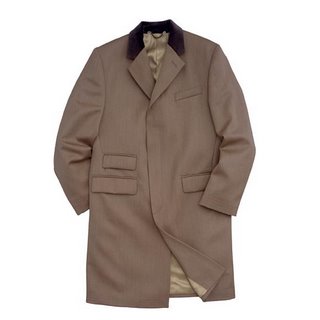That time of year...

The covert coat (pronounced ‘kuvert’)
"...During the next hundred years, the overcoat would assume a variety of shapes. Some of them are still with us, such as the raglan, the chesterfield and the covert. Others, like the ulster, the paletot, the inverness and the frock coat, have been left to molder in history's closet. This century has seen the addition of the macintosh, the polo and the British warm. All are the children of the greatcoat, but we should make one brief point of nomenclature here. By the turn of the twentieth century, the greatcoat had divided generically into two basic camps. There was a lighter-weight version, which was worn in the spring and fall of the year, and called a topcoat; since the 1940s this has been replaced by the ubiquitous raincoat in its various guises. The heavier version worn during the colder months of the year was called an overcoat. These terms still apply, and are worth keeping, although increasingly they are used interchangeably. Regardless of its weight and generic name, an outer garment must of course be both dolce et utile; it must offer both style and protection..."
"...The covert coat is named for the cloth from which it is made. The term comes from the French couvert, meaning a shady place or thicket, and in English came to mean a hiding place for game birds. Covert cloth is a twill-woven fabric in which a combination of two threads of different tones of the same color are twisted together to form a marled effect--i.e., a slightly mottled look rather than a clear color. The cloth itself is fairly stout, closely woven, and has a certain elasticity--all of which makes for a very resistant and durable material and a very smart-looking, long-wearing garment. It is sometimes waterproofed for additional protection.
While covert cloth can be used for trousers, jackets and a variety of field coats, its most popular use is for topcoats. Originally made as a country outer coat, the classic straight-cut, single-breasted,fly-fronted covert is always fawn-colored, although dressier mid-gray versions are often seen. Characterized by its four rows of stitches on each sleeve cuff and on the bottom hem, which falls no lower than the knee, the classic covert coat has two side pockets and a ticket pocket, and it's acceptable to add a green velvet collar cover for a dressier look..."
<< Home